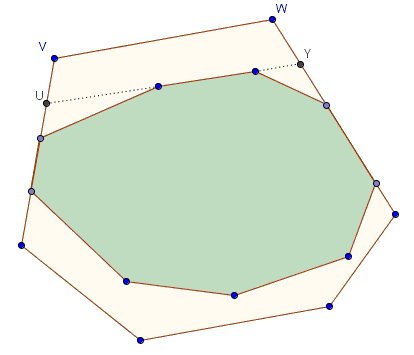Perimeters of Convex Polygons, One within the Other
Problem
Let P(X) denote the perimeter of polygon X.
Given two convex polygons S and T, S ⊂ T, S ≠ T. Prove that
Hint
At first site the statement seems obvious, although in general it touches on fundamental and deep properties of geometric shapes. But the problem is not about arbitrary plane regions - it's about convex polygons, and this could be utilized to our advantage. More specifically, the statement yields to an elegant proof by induction. What you want to do is find a discrete parameter that would make the inductive step all but obvious.
Solution
We are given that S ⊂ T, but it does not mean that the two polygons may not share a side line. For example, in the diagram below side A'B' of S lies on side AB of T (and, therefore, A'B' is not longer than AB.) The same is true concerning sides C'D' and CD of S and T respectively.

So S may or may not have some sides on the boundary of T. Let's agree to call sides of S that do not lie on any side of T free. The induction will be on the number of free sides of S.
If S has no free sides then each of its sides lies on a side of T and is, therefore, not longer than the latter. It follows that in this case
Now, for an inductive step, introduce statement X(k): "For two polygons
So let this be the case that S has k+1 free sides. Since

That line will split T into two, say, T' and T''. As we know, convex polygon are the intersections of half planes and so always lie on one side from their side lines, implying that S may belong to only one of T' or T''. Let it be T':
Acknowledgment
This is an example from a Russian book Simplest Examples of Mathematical Proofs by V. A. Uspensky (MCCME, 2009.)
Convex Sets
- Helly's Theorem
- First Applications of Helly's Theorem
- Crossed-Lines Construction of Shapes of Constant Width
- Shapes of constant width (An Interactive Gizmo)
- Star Construction of Shapes of Constant Width
- Convex Polygon Is the Intersection of Half Planes
- Minkowski's addition of convex shapes
- Perimeters of Convex Polygons, One within the Other
- The Theorem of Barbier
- A. Soifer's Book, P. Erdos' Conjecture, B. Grunbaum's Counterexample
- Reuleaux's Triangle, Extended
![]()
|Contact| |Front page| |Contents| |Geometry|
Copyright © 1996-2018 Alexander Bogomolny73578876
